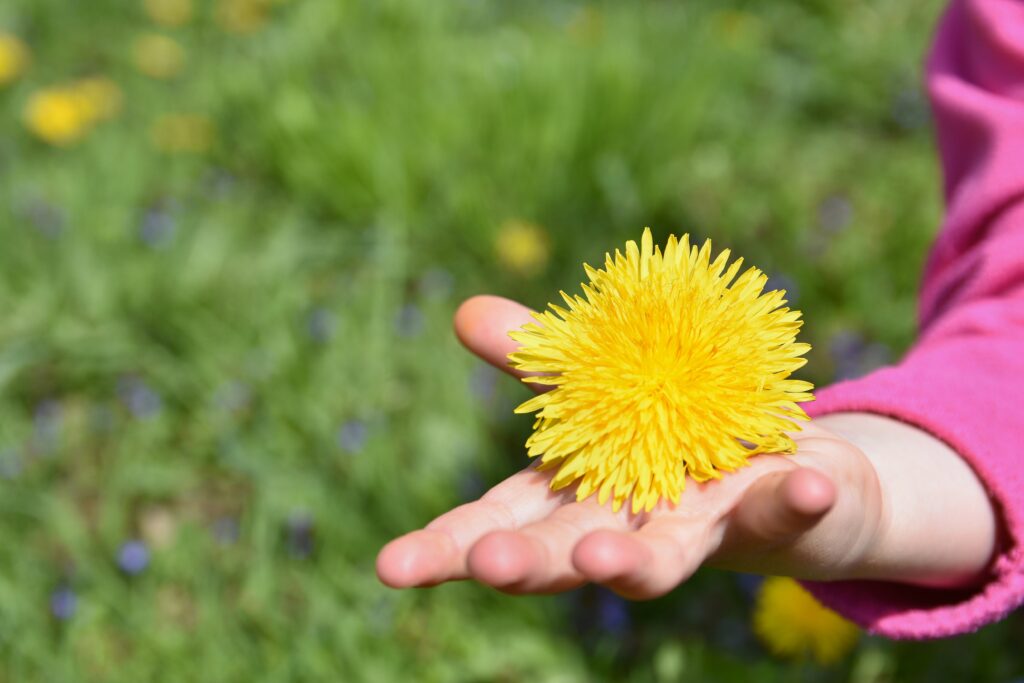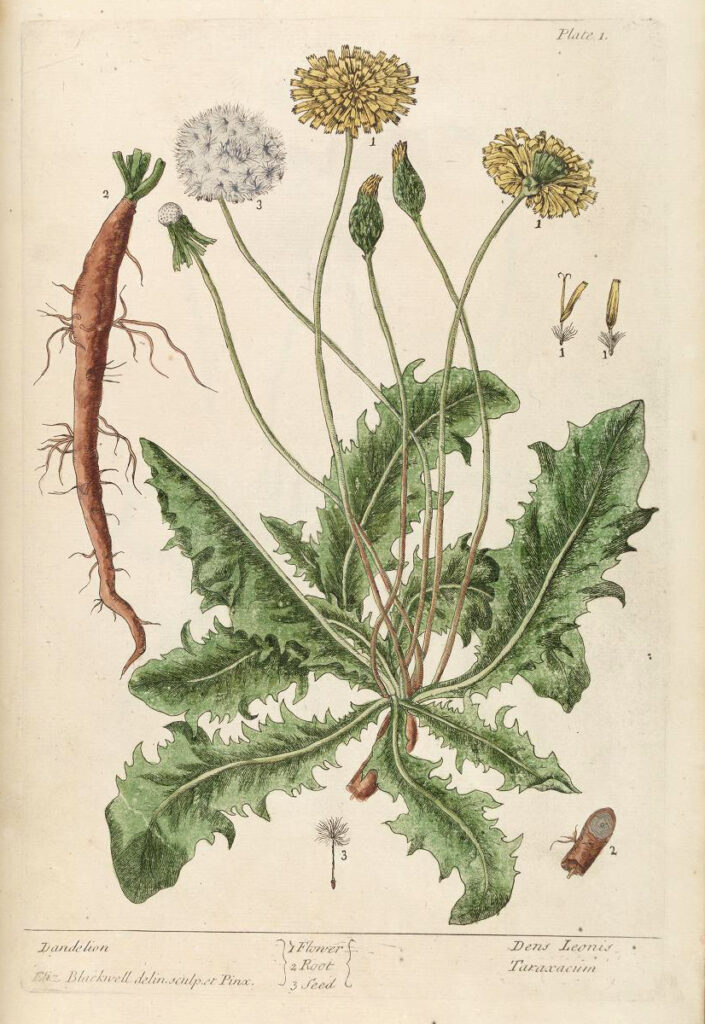
The First Dandelion
by Walt Whitman
Simple and fresh and fair from winter’s close emerging,
As if no artifice of fashion, business, politics, had ever been,
Forth from its sunny nook of shelter’d grass-innocent, golden, calm as the dawn,
The spring’s first dandelion shows its trustful face.
No one has ever chosen the dandelion as “Perennial of the Year” or “Herb of the Year.” I doubt they ever will! But dandelions are highly adaptive and diverse plants. They can colonize widely differing habitats, from a fertilized dense lawn to bare soil between plants in a tilled field. Most people consider them to be weeds, and this member of the Asteraceae family is actually an aggressive, invasive, non-native species.
Distinct dandelion biotypes (somewhat different genetically) have been identified, and to some degree these biotypes specialize in their choice of habitats. A dandelion in an environment that complements its biotype produces more seed heads than it would in a less complementary environment. This is due to differences in the root hairs, which absorb water and soil nutrients.
Not native to North America, dandelions, Taraxacum officinale, were brought to the west by Europeans who used them as potherbs. Dandelion use has a rich history. Dandelions were among the original bitter herbs of the Passover. The Israelites were commanded to eat the Paschal lamb “with unleavened bread and with bitter herbs” (Exodus 12:8). Bitter herbs consisted of chicory, bitter cresses, dandelions, hawk weed, sow thistles, and wild lettuce. Today these plants still grow on the peninsula of Sinai in Palestine and in Egypt.
Presently, Vineland, New Jersey is the “Dandelion Capital of the World.” Well-tended dandelions are sent from here to markets in Baltimore, New York City, and Philadelphia. At the yearly dandelion festival, attendees can sample a variety of dandelion dishes.
The genus name Taraxacumi may come from the Greek word “tatassein,” meaning “to disturb,” or as a Latinization of the Persian word “tarashqun,” meaning “bitter potherb.” The species name officinale refers to the dandelion’s root use in medicine.
The leaves of dandelion are pinnately lobed and deeply serrated, forming the “lion’s tooth” in outline, this is supposedly the origin of the “dent-de-lion.” Carolus Linnaeus, the father of the binomial system of nomenclature, gave the dandelion the name Leontodon taraxacum. Dandelion’s scientific name has changed several times. It has been called Taraxacum leontodon, T. taraxacum, and t. vulgare, the last name because it is “common.”
Dandelions have been used through history to treat disorders of the kidney and stomach. They are believed to be a bladder and kidney stimulant, lending the name “pissenlit” by the French and “pissabed” by the English. They are also believed to stimulate the liver and to increase blood circulation.
Dandelions can be eaten by livestock and don’t seem to affect the quality of forage.

The juice of dandelions is a milky latex. This shows up in dandelion’s nearest relatives as well . . . lettuce, chicory, hawks beard, and hawks weed. The leaves are delicious when young and are high in vitamins A and C as well as the minerals iron, copper, and phosphorus. Leaves are good in a salad, steamed, in a stir fry, or as an addition to soup.
You may have noticed dandelions in full sun, but they can grow in shade. They don’t seem to mind drought, probably due to their highly developed tap root. Stored food helps them survive. The roots usually grow from about six to eighteen inches deep but can grow to ten feet, giving dandelions the name “earth nail” by the Chinese. (Imagine digging that one out!) The roots are contractile, so the growing point of the dandelion plant is kept near the surface of the soil, the roots contracting while the rosette of leaves grows. The rosette of green leaves forms a circle, making it difficult for the seeds of other plants to compete. Look under the snow and you may see dandelion rosettes! In areas where soil is compacted, dandelion roots do some good as they “dig” into the soil, aerating it. If they are dug out, other plant species have an easier time getting established.
The flower buds of dandelions grow from the top of the root. There are no stems. So, if you cut off the top, the plant will simply regenerate from the root. (This explains why simply cutting the lawn does not rid you of dandelions.) Pulling or chopping is of little help, as pieces of the taproot grow into new plants. The roots are edible, though, and can be boiled, fried, or dried. Dried and roasted roots can be used as a coffee substitute similar to chicory, a close relative. Be careful when purchasing dandelion seeds to grow in your garden for the leaves. “Italian dandelion” seeds, for example, are actually chicory. Pay attention to the genus and species name. Those leaves simply don’t taste the same as true dandelions.
Dandelion flower stalks are hollow pseudo (false) stems ranging from about six inches to two feet. The flower heads are compound inflorescences about one to two inches in diameter. Each flower head is not a single flower with many petals but one hundred to three hundred identical ray flowers! (Take a flower apart and count them! “He loves me. He loves me not.”) Each ray flower has a yellow petal with five notches at the top. Look with a magnifying glass to see this. Flowering peaks in early summer but can recur in September and October.
Please take the time to observe the behavior of dandelion flowerheads. You will see that the heads open up through much of the day in the early spring but close up sometimes quite tightly by the middle of the day from about June through August. The flowerheads also remain closed on overcast days. Do you remember picking bouquets of dandelions as a child (or perhaps later)? The flower heads closed shortly after the flowerhead was picked. I remember thinking that my bouquets needed water so I put them in a glass of water. Nothing changed! The flowerheads also close when the seeds are maturing. Then they reopen for their release. Voila!
I keep honeybees. All pollinators are welcome, including native mason bees, native digger bees, and so forth. I love watching bees, some fly species, and occasional wasps probing dandelion flower heads. We have been taught that insects are attracted to plants by nectar and that in the process of gathering nectar the insects pollinate the flowers, a good exchange. BUT dandelions don’t need insects to pollinate them, as the fruit (the holders of the seeds) will develop asexually (parthenogenesis). Each individual flower produces seed whether or not an insect visits. This is called “apomixis.”It occurs in hundreds of plant species. Examples of apomixis include citrus plants, wild beets, strawberries, and some forage grasses. The seeds that are produced in these instances are all identical.
The seed heads of dandelions have interesting names: “blowball,” which is obvious, and “monkshead,” which is what the flowerhead looks like after the seeds blow off (a tonsure). The fruits of dandelions are actually achenes— simple, dry fruits with one seed inside each fruit about an eighth of an inch long. I looked at them under a microscope and the seeds looked ribbed. The achenes don’t split open; they float away in the parachute structure. They germinate on top or near the top of the soil. They don’t need a resting stage, so they germinate soon after landing.
You can dig dandelions in the wild, cut fresh leaves, or even cut the flowers for making wine. If you’re making dandelion wine you’ll need a lot, and I can tell you from experience that picking one gallon of dandelion flowerheads is quite an undertaking! Wash the flowerheads then remove the many thousands of individual flowers. Before harvesting the flowerheads please take care to ensure that they haven’t been sprayed with pesticides or by a passing creature. Or just let the flowers be . . . for insects and for children to enjoy.
If you wish to grow your own dandelions specially for greens, you can collect wild dandelion seeds. You can also purchase dandelion seeds from Johnny’s Selected Seeds. Most people who intentionally grow dandelions do so for the leaves. For good-tasting dandelion leaves cast the seeds in rich well-draining slightly alkaline soil. Plants need to be spaced about nine inches apart. Cut the leaves when young to reduce the possibility of a bitter taste. If you aren’t interested in the flowers cut them off so the plant’s energy goes back into leaf production. Fresh leaves can be harvested all season long.
The first time you use dandelions, do so cautiously. Some people react to the milky sap. The greens may disagree with your digestive system.
We have all held a dandelion flower head filled with seeds and blown those seeds away. What remains are said to be the number of remaining years of your life, predict whether or not you will meet someone to love, or tell whether or not you get into trouble with your mother. I did not know the lore of dandelions as a child. I blew the dandelion parachutes away because it was simply fun.
Fresh dandelion greens are delicious! Again, they can be steamed, stir-fried, and added to soups, eggs dishes, and fritters. If you think spinach, think dandelion greens. Their uses are unlimited!
Carol Ann Harlos is a Master Gardener with Cornell Cooperative Extension, Erie County.
This article originally appeared in the May/June 2025 issue of Upstate Gardeners’ Journal.
Views: 15






